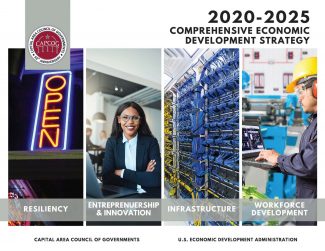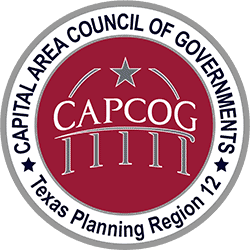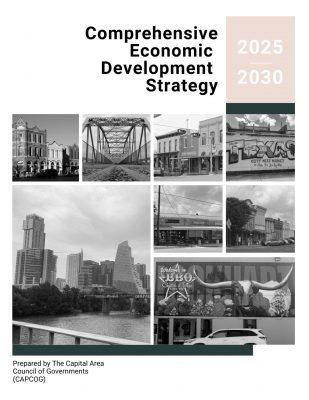Home » Services » Data, Maps & Reports » Comprehensive Economic Development Strategy
Comprehensive Economic Development Strategy
CAPCOG is designated by the U.S. Economic Development Administration (EDA) as the Economic Development District. Working on behalf of the district, CAPCOG develops the Comprehensive Economic Development Strategy (CEDS), a five-year plan that establishes regional economic goals and objectives. The strategy provides useful regional information, guidance, and perspective from and to local economic development stakeholders on a city, county, or regional level. The planning process is inclusive of diverse representatives in the public, private, and nonprofit sectors throughout the Capital Area. The strategy intends to provide a conceptual framework for local actors to strengthen the competitiveness, economic resilience, and quality of life in the Capital Area.
CEDS Contact
Kaileen McHugh
- Regional Planning & Services
- Planning and Economic Development Coordinator
- 512-916-6011
- kmchugh@capcog.org
2025-2030 Comprehensive Economic Development Strategies
The 2025–2030 CEDS establishes a framework for strengthening economic resilience, competitiveness, and quality of life across the Capital Area as it serves as a resource for local economic development stakeholders at the city, county, and regional levels.
The strategy uses key economic data, trends, and insights to help decision-makers understand regional challenges and opportunities to support and inform policy and economic decisions. It is made available throughout the region to facilitate collaboration among local governments, businesses, workforce organizations, and other stakeholders to foster partnerships and align resources.
CAPCOG completed the final strategy in June 2025 following months of research, regional outreach, and public engagement. The planning process emphasized local input with a focus on resiliency, sustainability, and shared opportunity. It includes a regional economic overview, SWOT analysis, strategic direction, and evaluation framework to guide the region through the next five years.
Strengths
- Strategic Location
- Population and Job Growth
- Educated and Growing Workforce
- Vibrant Quality of Life and Tourism Appeal
- Established and Emerging Industry Clusters
- Business Climate and Culture
Opportunities
- Enhancing the Middle-Skill Workforce for Industry Clusters
- Additional Support for Rural Workforce Development
- Connecting Workforce Housing with Employment Hubs
- Enhance Tourism through Regional Coordination
- Expand Broadband for Rural Economic Growth
- Strengthen Regional Collaboration
Weaknesses
- Labor Market Constraints
- Urban vs Rural Divide
- Transportation Infrastructure Strain
- Housing Affordability and Availability
- Water Infrastructure Challenges
Threats
- Resource Constraints
- Infrastructure Gaps and Traffic Congestion
- Dependence on Dominant Sectors
- Broadband Access Gaps
- Lack of Coordinated Planning
Foster a Dynamic Business Ecosystem
A region where businesses of all sizes thrive through innovation, collaboration, and opportunity—creating a resilient and diverse economy.
Advance Workforce Development
A region where residents can access meaningful career pathways and lifelong learning, and where employers find the skilled, adaptable talent they need to grow and compete.
Improve Infrastructure & Connectivity
A region powered by modern, reliable infrastructure that connects communities, supports economic growth, and prepares us for the future.
Enhance Quality of Place & Livability
A region where people want to live, work, and visit—defined by strong communities, accessible housing, and rich cultural and recreational experiences.
This page provides key insights into the region’s economic trends, workforce, and industry landscape. Our data comes from trusted sources, including the Bureau of Economic Analysis (BEA), the U.S. Census Bureau, and the Bureau of Labor Statistics. By analyzing these sources, we gain a comprehensive understanding of economic conditions, helping to shape informed strategies for regional growth and resilience.
The CEDS Data is coming soon.
Previous Years
Comprehensive Economic Development Strategies
Prior ceds and UPdates
CAPCOG is required by the EDA to develop a CEDS every 5 years, and provide an Update and Performance Report annually. Included below are CAPCOG’s last two CEDS and their updates.
- 2023 Update
- 2022 Update
- 2021 Update
- 2020-2025 CEDS
- 2019 Update
- 2018 Update
- 2017 Update
- 2016 Update
- 2015-2020 CEDS
2020-2025 CEDS
The strategy looked at the region’s many challenges that needed be addressed for it to remain economically competitive, despite the region have great economic success of recent years. It found that there was an over dependence on a few of the largest employment sectors, a lack of affordable housing resulting in increased commuting trips that threaten our air quality, stressed transportation infrastructure that could impact freight movement, a need for small business development in rural communities while dependable broadband is lacking, and significant disparities in educational attainment by race and ethnicity that limit the region’s ability to achieve its full economic potential.
Its last update was in 2024.



